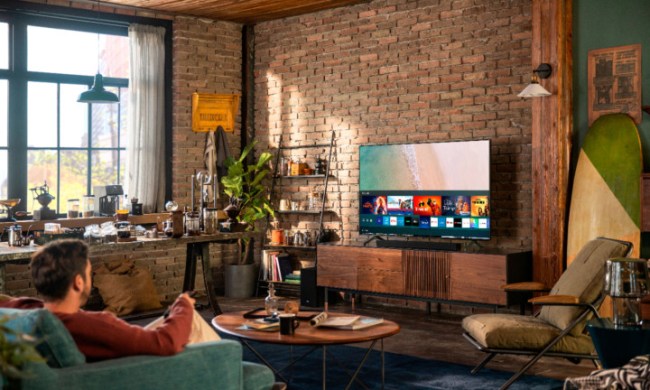
If you've spent any time researching or shopping for home theater products — whether TVs, soundbars, or full surround-sound systems — chances are you’re familiar with the phrase “Dolby Atmos.” Introduced in 2012, Dolby Atmos is one of the most immersive surround-sound formats available today.
Consumer technology has a penchant for putting hardware before software, and the rabbit hole of home theater devices is no exception to this rule. (You can purchase an 8K TV, but what can you watch on it?) That said, various audiovisual (AV) sectors have done well to keep up with the Atmos standard. You can currently experience Dolby Atmos with select Blu-rays and through an array of streaming platforms ... and that includes Netflix.
The short version is that you'll need to pony up for the most expensive Netflix streaming Premium plan if you want Atmos. Before we begin, though, let's break down Atmos a bit more to best understand the building blocks you'll need to get Atmos sound.
What is Dolby Atmos?
We’ve covered this groundbreaking audio codec in detail before, but the fundamentals are certainly worth reviewing.
Before Dolby Atmos, traditional surround-sound layouts were most commonly designated as 5.1 and 7.1 systems. In a 5.1 arrangement, the “home theater” is made up of three front speakers — referred to as the left, right, and center channels. Two rear speakers (left and right channels) complete the directional speaker family, with a subwoofer rounding out the sound staging for lower frequencies (the .1 in 5.1).

In a 7.1 arrangement, we keep the same speaker and subwoofer layout and add another two channels to the array. These two additional speakers can be used as either side-facing “surround” speakers or as additional “height” channels placed above the two front speakers.
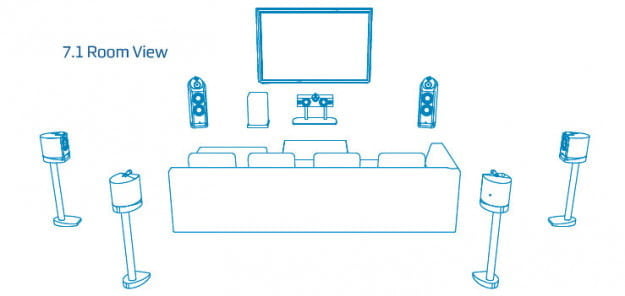
Dolby Atmos, by and large, is a surround format built around additional, height-focused channels. The end result? A complete 3D surround-sound experience that will get you as close to sitting in a real movie theater as humanly possible.
Common Atmos configurations include 5.1.2, 5.1.4, 7.1.2, and 7.1.4 — with the first digit representing the main speaker configuration, the second digit for how many subwoofers are in use, and the last number for how many dedicated Atmos height channels there are.
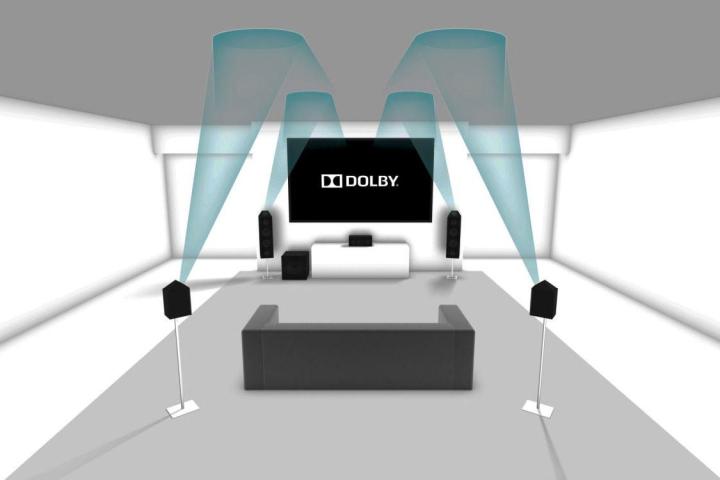
While the best way to achieve complete Dolby Atmos immersion is with dedicated, down-firing ceiling speakers in arrangements of two or four, you can also buy Atmos-ready floor-standing and bookshelf speakers that feature additional drivers on top of the cabinets. These top-speakers fire sound up toward the ceiling, where the waves are bounced back down for a simulated “height” effect.
If you’re limited on available real estate but still want to get as close to a full Atmos experience as possible, there are also some pretty amazing Dolby Atmos soundbars that are built from the ground up to tackle Atmos sound.
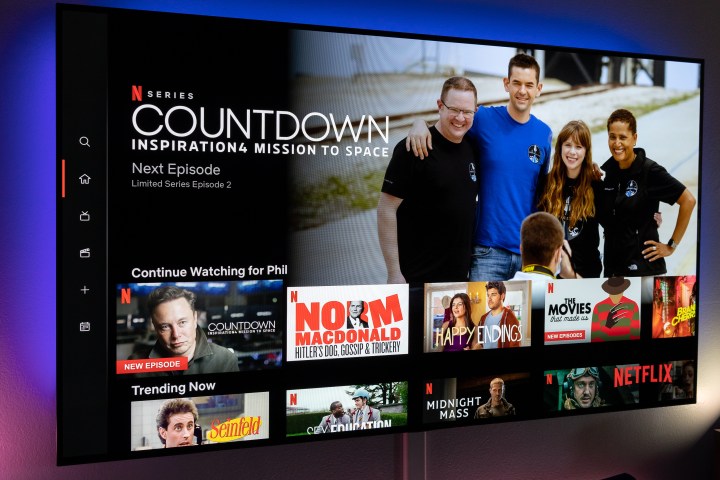
Atmos and Netflix: Premium sound meets premium pricing
One of the most popular ways to experience the mighty power of Dolby Atmos sound is through your Netflix subscription. Unfortunately for some of us, this is going to require a little more cash upfront to even get things started. This is because Netflix locks Dolby Atmos movies and shows behind the paywall of their most expensive monthly plan — the $20-a-month Premium tier.
Sure, Netflix’s $15.50-a-month Standard plan gets you unlimited HD streaming on two screens at once. But if you’ve already shelled out the dough for an Atmos speaker system or soundbar, chances are you have an incredible 4K TV to match your top-notch audio. For $20 a month, not only does Netflix’s Premium plan unlock Dolby Atmos sound (for available titles), but you also get access to a huge library of Netflix UHD movies and shows on up to four screens at once.
A daisy chain of Atmos-enabled devices
You’ve upgraded your Netflix plan and can now proudly call yourself a “Premium” subscriber. Great, so when does the Atmos-fun begin?
First things first: In addition to all of those Dolby Atmos speakers you painstakingly installed last weekend, in order to get complete Atmos sound, you need to ensure that every single component and connection lined in and out of your AV receiver, soundbar, and TV is properly equipped to handle and output Dolby Atmos.
If you plan on accessing Netflix from a streaming device like an Apple TV 4K or a Roku Streaming Stick, these devices need to be compatible with Dolby Atmos. The same goes for whatever HDMI cables (18Gbps or higher) you’ll be using to connect this hardware to your AV receiver or soundbar. And yes, you guessed it: Your receiver and soundbar absolutely need to be built to process the Atmos codec as well.
Planning on accessing Netflix through your smart TV? You’ll need to make sure your TV is capable of outputting Dolby Atmos back into your AV receiver or Atmos soundbar through HDMI ARC. You’ll also need to make sure that the version of Netflix’s app built for your TV (or AV device) can support Atmos through and through. Yes, it’s a little daunting, but truly, Netflix’s Atmos performance can vary from one piece of hardware to the next — something we discovered when examining the format up close.
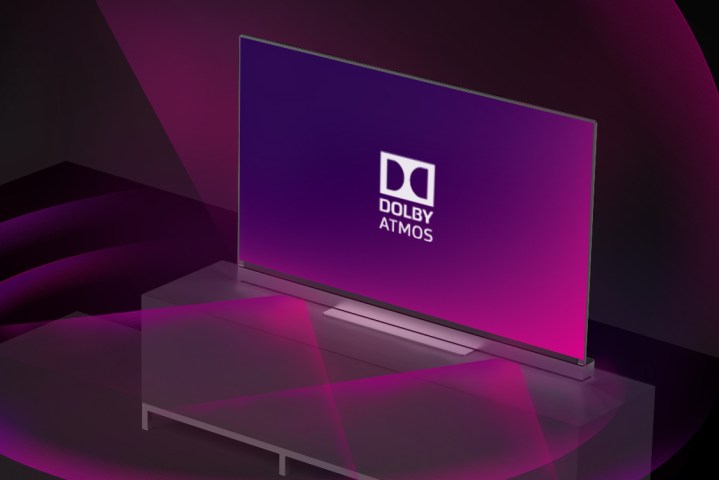
Confirm you’re actually hearing Dolby Atmos
When browsing through Netflix’s library of movies and shows, titles that are available in Dolby Atmos will display an Atmos icon next to their description.
Keep in mind that not every season or episode of a Dolby Atmos-compatible show will support Atmos. There are also a few language holdups to contend with, as not every TV show or movie on Netflix supports Atmos for every available language option.
With all that being said, is there a surefire way to know that the audio coming out of your Atmos speakers is actually Atmos sound? The short answer is yes. Most AV receivers and soundbars will feature some kind of display panel that will give you a readout of the type of surround sound codec it’s currently working with. In most cases, your display will read “Atmos” or “Dolby Atmos” when decoding Atmos audio.
If you’re outputting Atmos from a smart TV and into an AV receiver or soundbar, there’s a decent chance your TV will throw up some kind of quick Atmos indicator when you start streaming your Atmos movie or show.
Better yet, if your TV remote has some kind of Info or Status button, after pressing one of these, you should see some kind of small readout on your TV screen that tells you what resolution is being displayed, what refresh rate the TV is working with, and what type of audio is being processed. If “Atmos” is written out in full or abbreviated, this means your TV is successfully sending Netflix-powered Atmos back into your AV system.
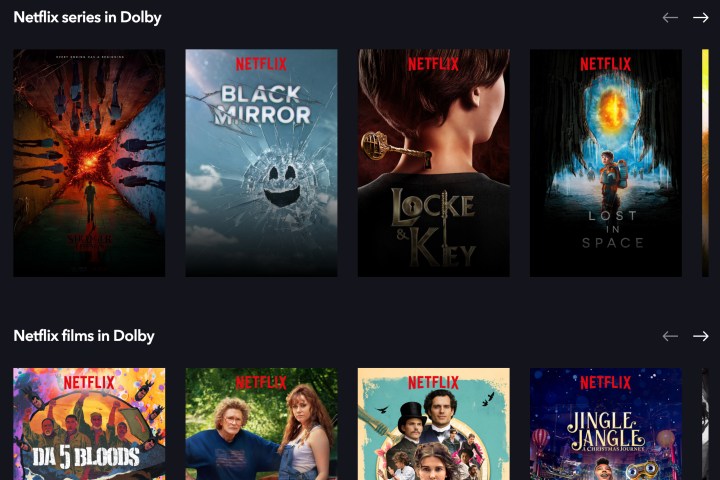
Finding available Netflix content in Dolby
You're all set up, and you know your system can produce real Dolby Atmos sound. Now, how do you find Dolby Atmos content on Netflix? It's all about watching for the logo.
Netflix titles that support Dolby Atmos have a small speaker icon with the word "Atmos" next to it. Watch for this logo, and you'll know that you'll get the Atmos sound experience. Commonly supported shows include Stranger Things, Black Mirror, Locke & Key, Lost in Space, Ozark, The Umbrella Academy, and more (plus a variety of movies).
Note that Netflix titles that have Dolby Atmos also supported Dolby Vision, so if you have a compatible display, you will also be getting visual optimization, too.
Interested in upgrading your system to support Dolby Atmos? We have just the place for you to start: our guide to the best Atmos-compatible soundbars you can find, with picks like the Sonos Arc and full surround-sound systems from Samsung.

